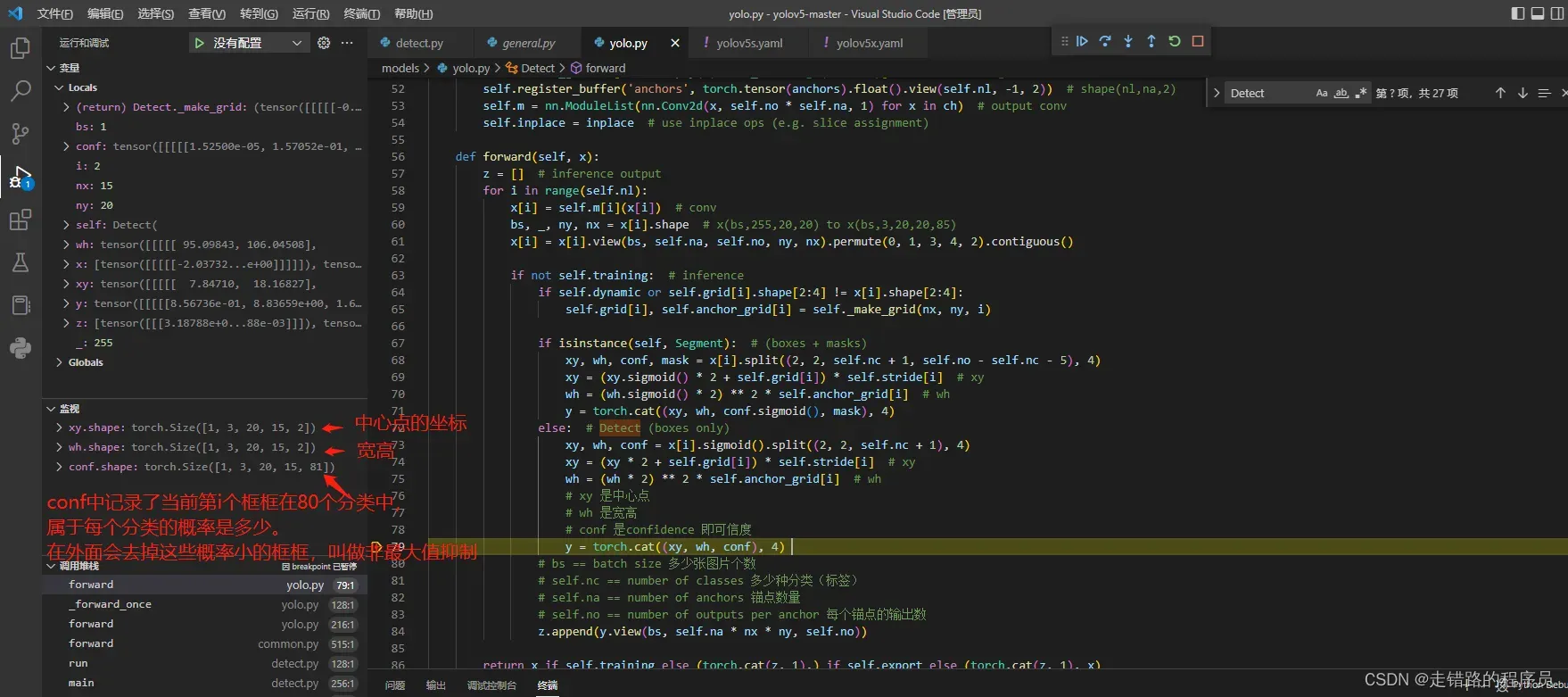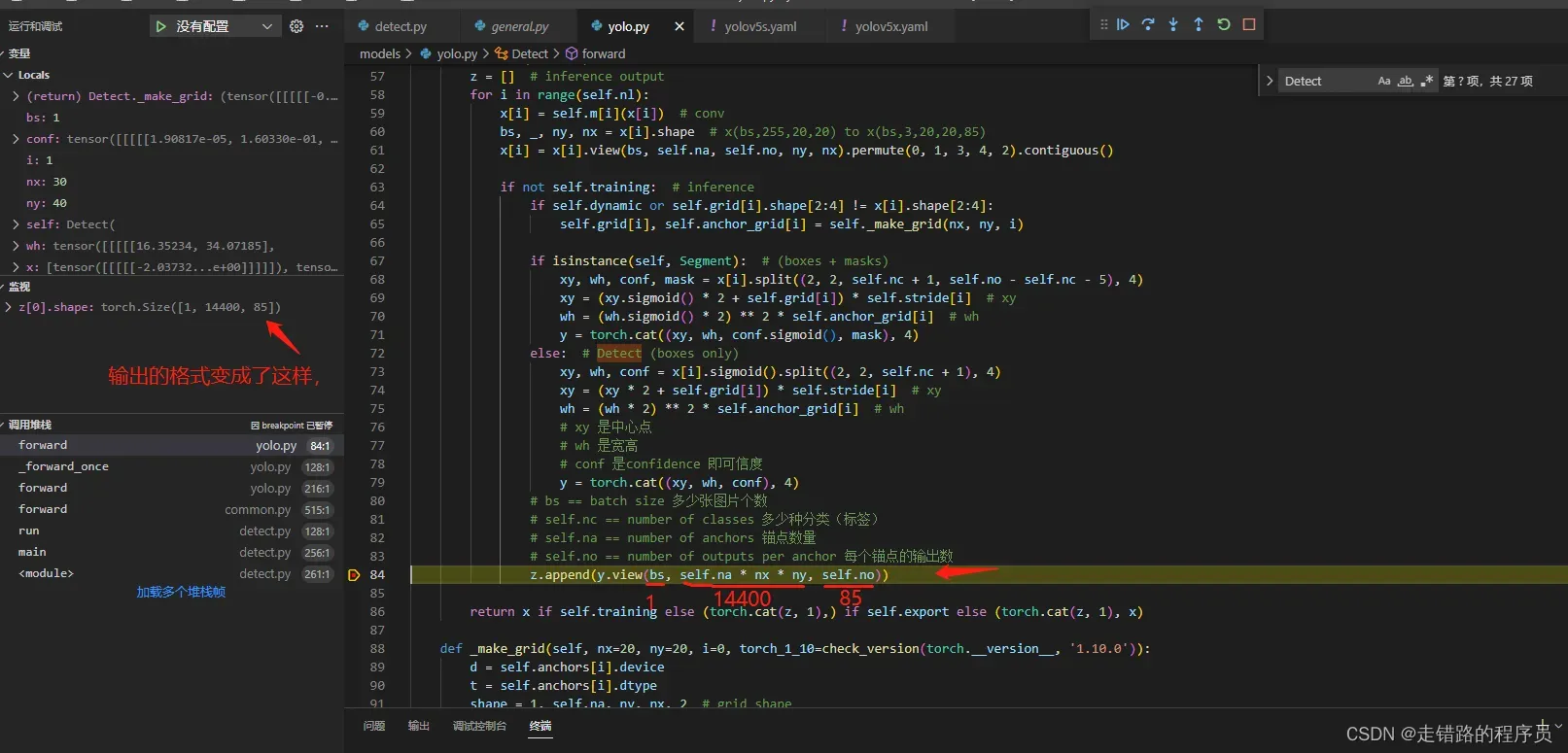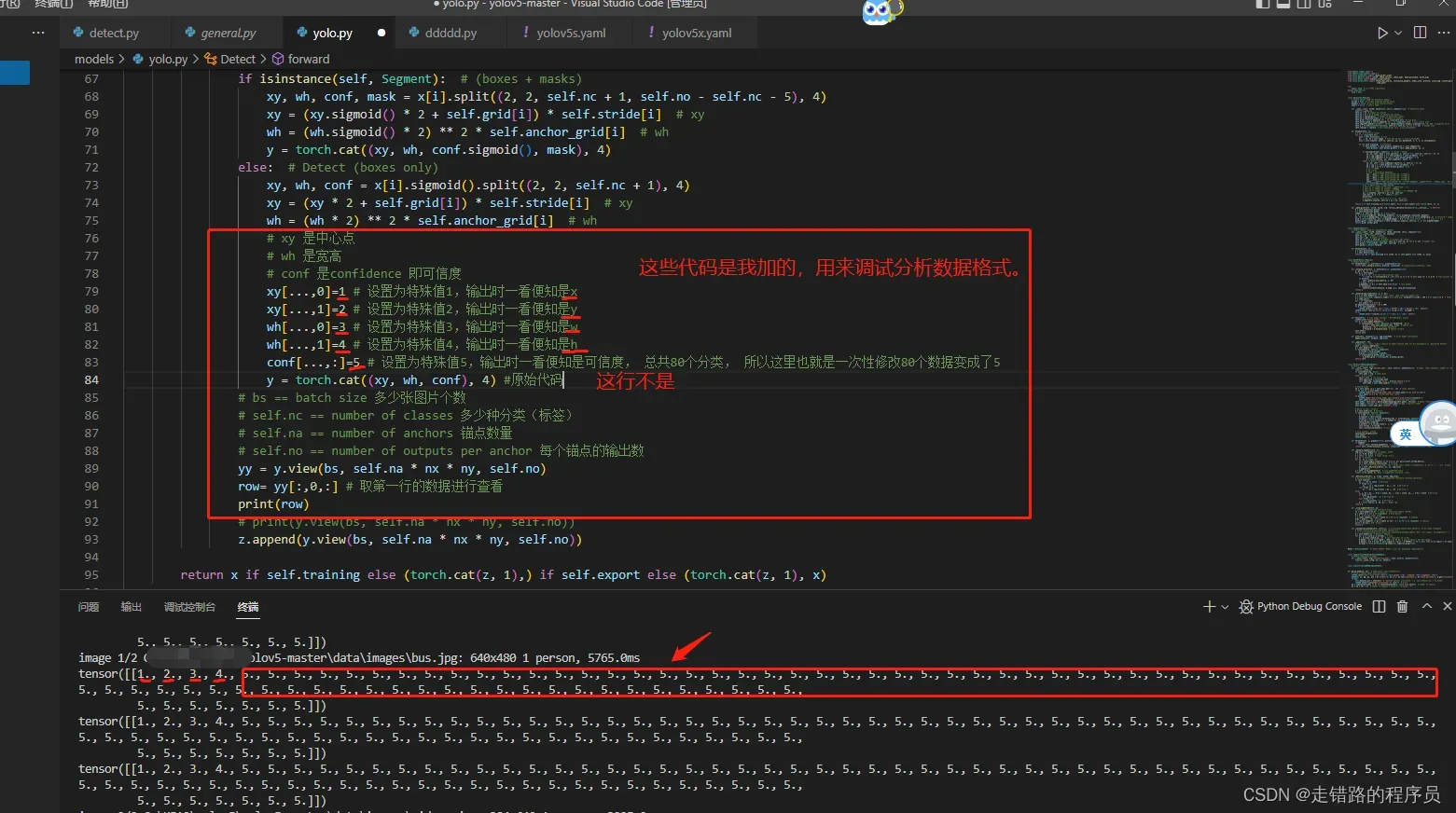工作需要, 又需要对yolov5 输出的模型进行转onnx 再用c++进行后续处理。
两个问题。
- yolov5 的模型输出的是个啥啊?
- 转成onnx后输出的和yolov5输出的处理是否一样呢?
关于第一个问题,yolov5 的模型输出的是个啥啊?
以前只知道抄代码就行, 也不知道里面干了啥 , 输出的后处理也都是由现成的代码来实现。 我也懒得考虑内部的原理, 反正代码正常跑。系统正常运行就可以。
但是今天不行啦, 得自己解析输出。 被逼无奈之下, 只能仔细研究下yolov5的模型和其内部的神经网络结构。关于神经网络的结构, 主要是在文件 models\yolov5s.yaml 中定义的。具体的我在下面的文件中注释写进去了。
# YOLOv5 🚀 by Ultralytics, GPL-3.0 license
# Parameters
nc: 80 # number of classes
depth_multiple: 0.33 # model depth multiple
width_multiple: 0.50 # layer channel multiple
anchors:
- [10,13, 16,30, 33,23] # P3/8
- [30,61, 62,45, 59,119] # P4/16
- [116,90, 156,198, 373,326] # P5/32
# YOLOv5 v6.0 backbone
backbone:
# [from, number, module, args]
# 关键是这个说明, 这里得分成4个看,分别是
# [from 数据从哪里来, number 有几个这样的层, module 层的名称, args参数]
[[-1, 1, Conv, [64, 6, 2, 2]], # 0-P1/2
[-1, 1, Conv, [128, 3, 2]], # 1-P2/4
#下面这个配置的意思是,数据从-1层(上一层)来,创建3层类名叫C3的层, 参数是128
[-1, 3, C3, [128]],
#下面这个配置的意思是,数据从-1层(上一层)来,创建1层类名叫Conv的层, 参数是256, 3, 2
[-1, 1, Conv, [256, 3, 2]], # 3-P3/8
[-1, 6, C3, [256]],
[-1, 1, Conv, [512, 3, 2]], # 5-P4/16
[-1, 9, C3, [512]],
[-1, 1, Conv, [1024, 3, 2]], # 7-P5/32
[-1, 3, C3, [1024]],
[-1, 1, SPPF, [1024, 5]], # 9
]
# YOLOv5 v6.0 head
head:
[[-1, 1, Conv, [512, 1, 1]],
[-1, 1, nn.Upsample, [None, 2, 'nearest']],
[[-1, 6], 1, Concat, [1]], # cat backbone P4
[-1, 3, C3, [512, False]], # 13
[-1, 1, Conv, [256, 1, 1]],
[-1, 1, nn.Upsample, [None, 2, 'nearest']],
[[-1, 4], 1, Concat, [1]], # cat backbone P3
[-1, 3, C3, [256, False]], # 17 (P3/8-small)
[-1, 1, Conv, [256, 3, 2]],
[[-1, 14], 1, Concat, [1]], # cat head P4
[-1, 3, C3, [512, False]], # 20 (P4/16-medium)
[-1, 1, Conv, [512, 3, 2]],
[[-1, 10], 1, Concat, [1]], # cat head P5
[-1, 3, C3, [1024, False]], # 23 (P5/32-large)
[[17, 20, 23], 1, Detect, [nc, anchors]], # Detect(P3, P4, P5)
]
这个配置文件的解析是在models\yolo.py 文件中 由 parse_model() 方法执行解析的。
下面贴一下这个函数的代码,如果没兴趣可以不看
从代码中可以看的出来,配置文件中的最后一列 arg参数, 并不是跟代码中class的参数一一对应的。
例如Conv参数在代码中需要好多个参数, 而配置文件中只配置了3个。(我非常反感这种配置来配置去,搞脑子的写法, 因为非常的不方便代码理解, 不如直接在代码中硬编码, 最好的代码是一看就懂。
)
def parse_model(d, ch): # model_dict, input_channels(3)
# Parse a YOLOv5 model.yaml dictionary
LOGGER.info(f"\n{'':>3}{'from':>18}{'n':>3}{'params':>10} {'module':<40}{'arguments':<30}")
anchors, nc, gd, gw, act = d['anchors'], d['nc'], d['depth_multiple'], d['width_multiple'], d.get('activation')
if act:
Conv.default_act = eval(act) # redefine default activation, i.e. Conv.default_act = nn.SiLU()
LOGGER.info(f"{colorstr('activation:')} {act}") # print
na = (len(anchors[0]) // 2) if isinstance(anchors, list) else anchors # number of anchors
no = na * (nc + 5) # number of outputs = anchors * (classes + 5)
layers, save, c2 = [], [], ch[-1] # layers, savelist, ch out
for i, (f, n, m, args) in enumerate(d['backbone'] + d['head']): # from, number, module, args
m = eval(m) if isinstance(m, str) else m # eval strings
for j, a in enumerate(args):
with contextlib.suppress(NameError):
args[j] = eval(a) if isinstance(a, str) else a # eval strings
n = n_ = max(round(n * gd), 1) if n > 1 else n # depth gain
if m in {
Conv, GhostConv, Bottleneck, GhostBottleneck, SPP, SPPF, DWConv, MixConv2d, Focus, CrossConv,
BottleneckCSP, C3, C3TR, C3SPP, C3Ghost, nn.ConvTranspose2d, DWConvTranspose2d, C3x}:
c1, c2 = ch[f], args[0]
if c2 != no: # if not output
c2 = make_divisible(c2 * gw, 8)
args = [c1, c2, *args[1:]]
if m in {BottleneckCSP, C3, C3TR, C3Ghost, C3x}:
args.insert(2, n) # number of repeats
n = 1
elif m is nn.BatchNorm2d:
args = [ch[f]]
elif m is Concat:
c2 = sum(ch[x] for x in f)
# TODO: channel, gw, gd
elif m in {Detect, Segment}:
args.append([ch[x] for x in f])
if isinstance(args[1], int): # number of anchors
args[1] = [list(range(args[1] * 2))] * len(f)
if m is Segment:
args[3] = make_divisible(args[3] * gw, 8)
elif m is Contract:
c2 = ch[f] * args[0] ** 2
elif m is Expand:
c2 = ch[f] // args[0] ** 2
else:
c2 = ch[f]
print("模型结构" + str(m) + str(args)+"\r\n")
m_ = nn.Sequential(*(m(*args) for _ in range(n))) if n > 1 else m(*args) # module
t = str(m)[8:-2].replace('__main__.', '') # module type
np = sum(x.numel() for x in m_.parameters()) # number params
m_.i, m_.f, m_.type, m_.np = i, f, t, np # attach index, 'from' index, type, number params
LOGGER.info(f'{i:>3}{str(f):>18}{n_:>3}{np:10.0f} {t:<40}{str(args):<30}') # print
save.extend(x % i for x in ([f] if isinstance(f, int) else f) if x != -1) # append to savelist
layers.append(m_)
if i == 0:
ch = []
ch.append(c2)
return nn.Sequential(*layers), sorted(save)
回归正题, 根据yolov5s.yaml配置文件来看, 模型的最后一层是Detect层
只要看懂了Detect的代码既能理解yolov5到底输出了啥。
为方便快速理解,我下面把Detect层的 class 源代码贴出来。
源代码在models\yolo.py 文件中 38 行
class Detect(nn.Module):
# YOLOv5 Detect head for detection models
stride = None # strides computed during build
dynamic = False # force grid reconstruction
export = False # export mode
def __init__(self, nc=80, anchors=(), ch=(), inplace=True): # detection layer
super().__init__()
self.nc = nc # number of classes
self.no = nc + 5 # number of outputs per anchor
self.nl = len(anchors) # number of detection layers
self.na = len(anchors[0]) // 2 # number of anchors
self.grid = [torch.empty(0) for _ in range(self.nl)] # init grid
self.anchor_grid = [torch.empty(0) for _ in range(self.nl)] # init anchor grid
self.register_buffer('anchors', torch.tensor(anchors).float().view(self.nl, -1, 2)) # shape(nl,na,2)
self.m = nn.ModuleList(nn.Conv2d(x, self.no * self.na, 1) for x in ch) # output conv
self.inplace = inplace # use inplace ops (e.g. slice assignment)
def forward(self, x):
z = [] # inference output
for i in range(self.nl):
x[i] = self.m[i](x[i]) # conv
bs, _, ny, nx = x[i].shape # x(bs,255,20,20) to x(bs,3,20,20,85)
x[i] = x[i].view(bs, self.na, self.no, ny, nx).permute(0, 1, 3, 4, 2).contiguous()
if not self.training: # inference
if self.dynamic or self.grid[i].shape[2:4] != x[i].shape[2:4]:
self.grid[i], self.anchor_grid[i] = self._make_grid(nx, ny, i)
if isinstance(self, Segment): # (boxes + masks)
xy, wh, conf, mask = x[i].split((2, 2, self.nc + 1, self.no - self.nc - 5), 4)
xy = (xy.sigmoid() * 2 + self.grid[i]) * self.stride[i] # xy
wh = (wh.sigmoid() * 2) ** 2 * self.anchor_grid[i] # wh
y = torch.cat((xy, wh, conf.sigmoid(), mask), 4)
else: # Detect (boxes only)
xy, wh, conf = x[i].sigmoid().split((2, 2, self.nc + 1), 4)
xy = (xy * 2 + self.grid[i]) * self.stride[i] # xy
wh = (wh * 2) ** 2 * self.anchor_grid[i] # wh
# xy 是中心点
# wh 是宽高
# conf 是confidence 即可信度
y = torch.cat((xy, wh, conf), 4)
z.append(y.view(bs, self.na * nx * ny, self.no))
return x if self.training else (torch.cat(z, 1),) if self.export else (torch.cat(z, 1), x)
def _make_grid(self, nx=20, ny=20, i=0, torch_1_10=check_version(torch.__version__, '1.10.0')):
d = self.anchors[i].device
t = self.anchors[i].dtype
shape = 1, self.na, ny, nx, 2 # grid shape
y, x = torch.arange(ny, device=d, dtype=t), torch.arange(nx, device=d, dtype=t)
yv, xv = torch.meshgrid(y, x, indexing='ij') if torch_1_10 else torch.meshgrid(y, x) # torch>=0.7 compatibility
grid = torch.stack((xv, yv), 2).expand(shape) - 0.5 # add grid offset, i.e. y = 2.0 * x - 0.5
anchor_grid = (self.anchors[i] * self.stride[i]).view((1, self.na, 1, 1, 2)).expand(shape)
return grid, anchor_grid
从代码
# xy 是中心点
# wh 是宽高
# conf 是confidence 即可信度
y = torch.cat((xy, wh, conf), 4)
中可以看的出, 这里是输出的主要数据的格式, 分别是3个参数 xy 中心点, wh 宽高,conf 可信度
经过调试发现数据的格式如下。

关键要看shape的最后一位,在这一步的时候,不是最终输出的格式,这里只是把它们合并起来了。后面还有个y.view进行了重新改变维度, 让这个组合的矩阵变的更加的直观, 改变维度后, 它的shape变成了

实际内部存储仍然是
[[
[xy1,wh1,conf1,conf2,...,conf81],
[xy2,wh2,conf1,conf2,...,conf81],
[xy3,wh3,conf1,conf2,...,conf81],
....
]]
这里再补充一下,实际内部格式是
[[
[x1,y1,w1,h1,conf1,conf2,...,conf81],
[x2,y2,w2,h2,conf1,conf2,...,conf81],
[x3,y3,w3,h3,conf1,conf2,...,conf81],
....
]]
这里再补充一下,并非每一行都是按照同样的算法计算最后的box, 需要乘上一个参数 anchors,
anchors参数在yolov5s.yaml中有定义, 关于什么是 anchors 这里不展开讲, (太多,我也没理解透,不敢乱讲)
我自己的大致理解是, 这3组参数,分别对应不同缩放图片的锚点参数,缩放倍数分别是 8倍,16倍,32倍。
起到可识别大物品和小物品的作用。(关于这3组框框,仅为我个人见解不一定正确。仅供参考)
anchors:
- [10,13, 16,30, 33,23] # P3/8
- [30,61, 62,45, 59,119] # P4/16
- [116,90, 156,198, 373,326] # P5/32
[[
[x1,y1,w1,h1,conf1,conf2,...,conf81], #这里应该是8倍的数据
[x2,y2,w2,h2,conf1,conf2,...,conf81], #这里应该是16倍的数据
[x3,y3,w3,h3,conf1,conf2,...,conf81], #这里应该是32倍的数据
[x4,y4,w4,h4,conf1,conf2,...,conf81], #这里应该是8倍的数据
[x5,y5,w5,h5,conf1,conf2,...,conf81], #这里应该是16倍的数据
[x6,y6,w6,h6,conf1,conf2,...,conf81], #这里应该是32倍的数据
....
]]
这里一行数据,代表一个识别的框框box,后面的conf1到81分别是这个框框在每个标签类上的可信度。
这里的xy,wh的单位,不是像素哦, 是归一化后的数值, 需要按比例转换成像素值(还需要根据锚点anchors 进行转换)。 然后画到图片上就行了
xy的坐标是框框中心点的坐标,而不是左上角的坐标哦。
知道了存储的数据格式,后续的处理,实际上就很简单了。
分别是去掉可信度比较低的框框, 叫做非极值抑制,也就是这个函数non_max_suppression(). 有的叫 nms
然后就是把可信度比较高的框框画到图片上。剩下的应该都能看的懂。
关于我是怎么知道最终数据格式并知道其每个维度的数据的意义的?
实际上我并没有查看yolov5的论文(其实是没怎么看明白!!!), 而是用了比较程序员式的方法 —-> 调试代码, 数据改成特殊数值,然后输出就知道啦。 方法分享给大家, 愿大家可以用此方法分析更多的框架。

文章出处登录后可见!
